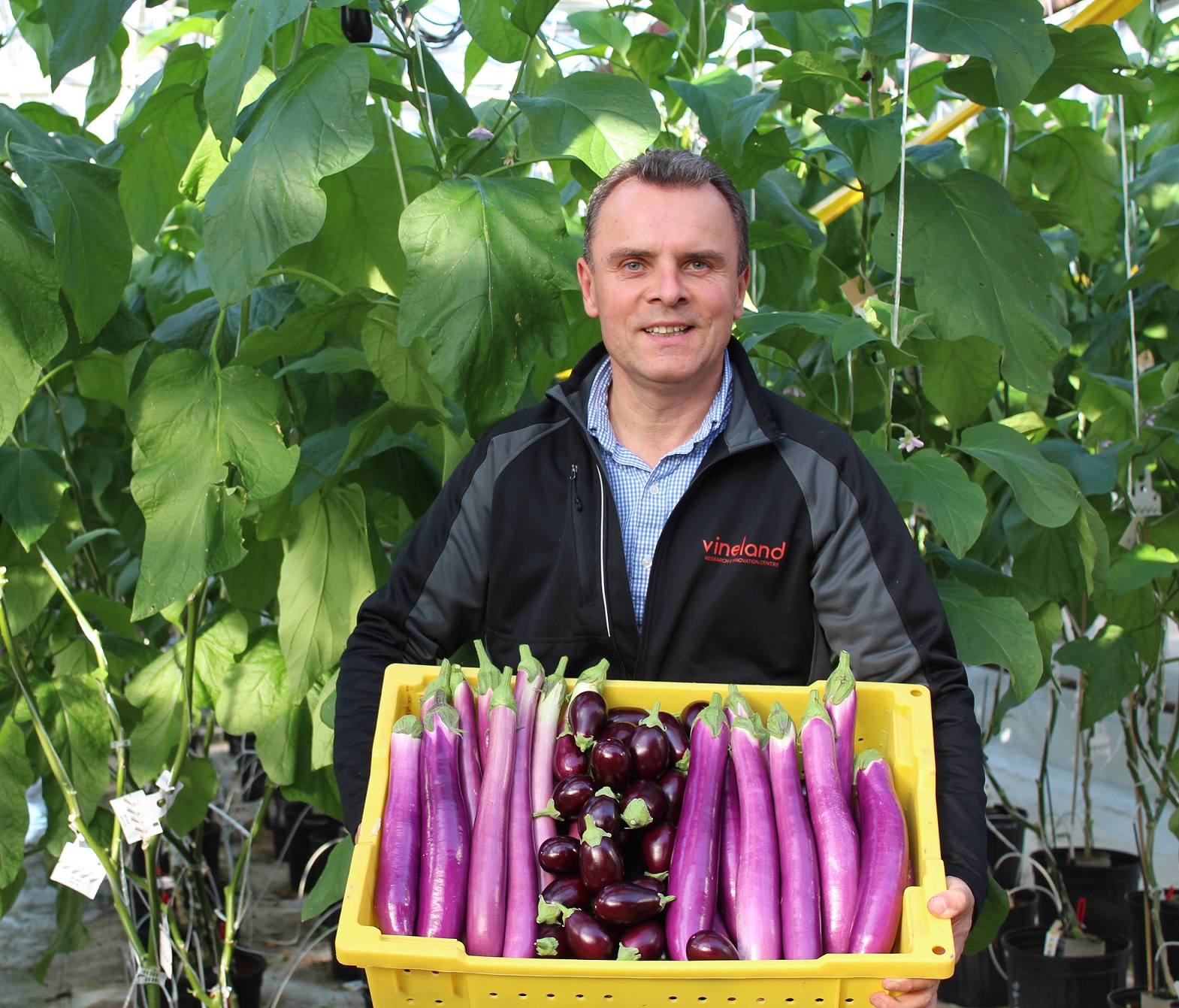Canadian project aims for year-round ethnic eggplant production

If a Vineland Research and Innovation Centre project hits the right greenhouse yields, Chinese and Indian variety eggplants could become a predominantly local deal in Canada. At www.freshfruitportal.com we caught up with Vineland agronomist Dr. Viliam Zvalo, who explained how the government-backed initiative catered to the country's growing diversity, with field trials already showing promising results.
Based on Statistics Canada patterns over the last five years, Vineland expects domestic eggplant consumption to rise 130% by 2030, reaching 55 million kilograms, driven particularly by exotic varieties not previously grown locally.
This trend prompted a grant from Agri-Food Canada's agricultural innovation program 'Growing Forward 2', which combined with support from the Ontario Fruit and Vegetable Growers' Association led to the Vineland project which will last until 2018.

Dr. Viliam Zvalo with the Chinese long (left and right) and Indian round (center) eggplant varieties.
"We are trying to develop the production system here in Canada so that the farmers can make a business case out of it and supply these crops," Zvalo said.
He said the biggest difference between these varieties and more traditional eggplants is how they are used.
"The Chinese long eggplant is not bitter - the regular type of Italian eggplant has to be salted and the bitterness has to be taken out of it before cooking. Sometimes retailers refer to them as sweet eggplants, although they don't have any sugars.
"It basically fits the modern lifestyle a bit better as you can chop it up in a stir-fry and not worry about any preparations, salting, juices or any of that," he said, adding the situation was the same for the Indian round eggplant.
Last year the project involved field trials with 22 growers across Canada to identify which cultivars best matched consumer demand while also producing good yields and holding up to disease.
"In the field situation, the eggplant is actually producing quite well so the yields are in the neighborhood of 30-50[metric] tons per hectare," he said, adding this had been achieved with help from row covers and black plastic mulch.
"So the field production in that system from July to October is quite justified. If the growers learn how to fertilize, how to space the eggplant, how to treat for diseases and insects, the production is there.
"For instance, the crop does really well in Ontario, British Columbia and Quebec, and that’s where most of the demand lies. There’s actually a grower who started trialing last year different varieties and he’s going to grow five to seven acres and supply the Vancouver area.
"There are several growers here in southern Ontario and some of them have been supplying, and new growers trialed the varieties last year and they're going to supply various retailers in the region."
He said most of the current supply comes from U.S.-based companies sourcing from Caribbean countries like Honduras, Nicaragua and the Dominican Republic.
"If we only supplied in the summer that would be mostly from July to September, when the Caribbean is actually adversely affected by hurricanes and the heat of the summer.
"Let’s face it, for most of the year we’d still need imports and we can only grow in the field for three months.
"But in the greenhouse industry, technically we could develop a production system where we could supply almost year-round."
And that's where the challenge comes in - the project's second component.
Greenhouse goals
Zvalo said last year's greenhouse project was quite small and the plants could only grow up to three meters, but in 2016 Vineland will be able to take a more extensive approach.
"To give you an idea, one cycle we’re getting 10-12kg per square meter in a 12-week harvest, so in a 24-week harvest period we get about 20-24kg of eggplants per square meter. For the growers to get really excited we’d have to push it up to the high 30s.
"With this yield I’ve described, that was achieved with tomato rootstock to get them bigger, because in a greenhouse you need to get the plants growing to three or five meters. The grafting increased the yield anywhere between 22-95%, so we know grafting is definitely the way to go."
In 2015, the researchers only used one rootstock, tested with nine different varieties with the Long Purple and Purple Comet hybrids showing the most promise. In the field trials, the best yield potential came from the Asia Beauty, Farmers' Long and Long Purple hybrids.
"In 2016 we just set the plants into the new greenhouse where we have eight varieties in the main block, and they are replicated on six different rootstocks to find the best combination of rootstock and the scion or the growing variety.
"Then we have the observation block with about 20 varieties grafted on different rootstocks, just to see how they’re doing. If they do well, then we’ll add them into the main block for the following year.
"We are planning to grow this until the middle of December. A year from now we’ll have a very good idea of where we are on yields in the high-tech greenhouse."
Vineland will have no intellectual property (IP) rights to the results of its research, with the resulting information to be released to the industry.
"I definitely get excited about this because it is an opportunity where Canadian growers can benefit from the changing demographic and the shift in the marketplace. That’s what excites me in the morning to get up and go to work," Zvalo said, adding there was also similar research underway with okra varieties.









































